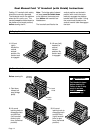
Page 12
Manual Bridge Plate
Platform at Stow Level
A
Platform at Floor Level
Vehicle Floor
Floor Level Bridge Plate
(Bridging Position)
Engaged - Vertical
Bridge Plate
Platform at Floor Level
Vehicle Floor
Move vertical
bridge plate
to right to
disengage it,
and then
lower it to the
floor.
Manual Bridge Plate
Platform at Floor Level
Gap between Lift and Floor
Vehicle Floor
D
E
F
Manual Bridge Plate Operating Instructions
The bridge plate bridges the gap between the lift platform
and the vehicle floor when the lift platform is raised fully
(positioned at floor level), as well as serving as an inboard
roll stop.
Manual bridge plates are attendant operated. The bridge
plate rests on the platform surface when the lift is in the
stowed position (see Photo A). When the platform is fully
extended and raised or lowered to the desired height, the
bridge plate is manually positioned as needed.
When raised to the vertical position, the rear (left) end of
the plate engages a notch in the angled engagement
bracket located at the inboard end of the platform side
plate. See Photos B and C. The spring located on the
opposite end of the bridge plate hinge places rearward
pressure on the bridge plate to retain the plate in the
vertical position (engaged in bracket notch).
When the platform is raised to floor level, the bridge plate
is manually lowered to the vehicle floor (bridging position)
by moving the bridge plate to the right to disengage it, and
then lowering it to the floor. From the floor level bridging
position, the bridge plate is manually raised to the vertical
position (see Photos D, E and F).
The bridge plate can be folded down to the platform
surface by the attendant before stowing the lift platform, or
the stowing (retracting) movement of the platform will push
the bridge plate down as it contacts the lift carriage.
Engaged
Vertical
Bridge Plate
C
Bridge Plate
Engagement Bracket
Floor Level
Bridge Plate
Engagement
Notch
B
Vertical Bridge Plate Engagement


















